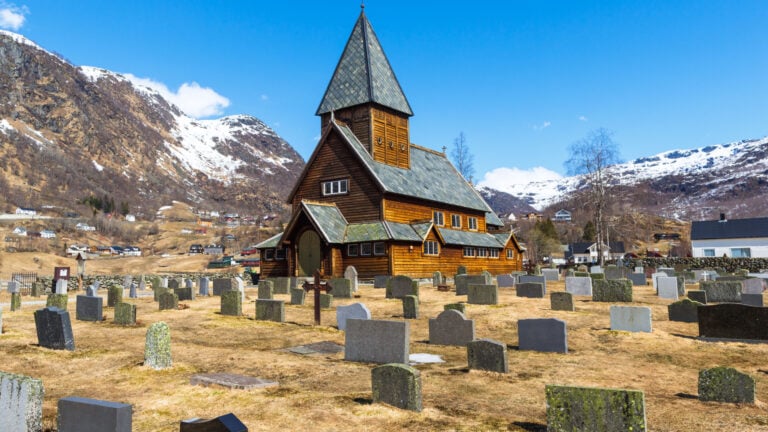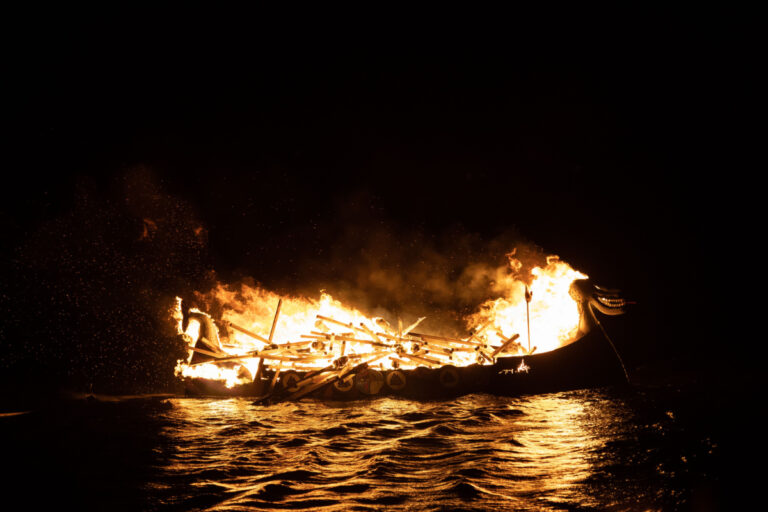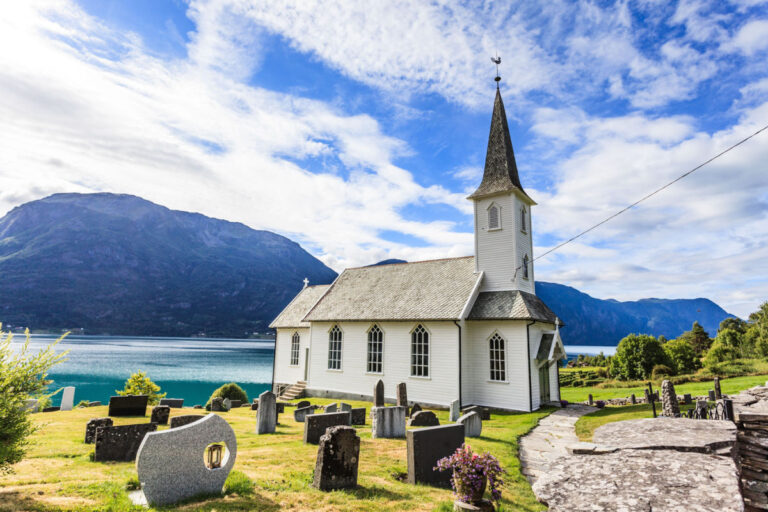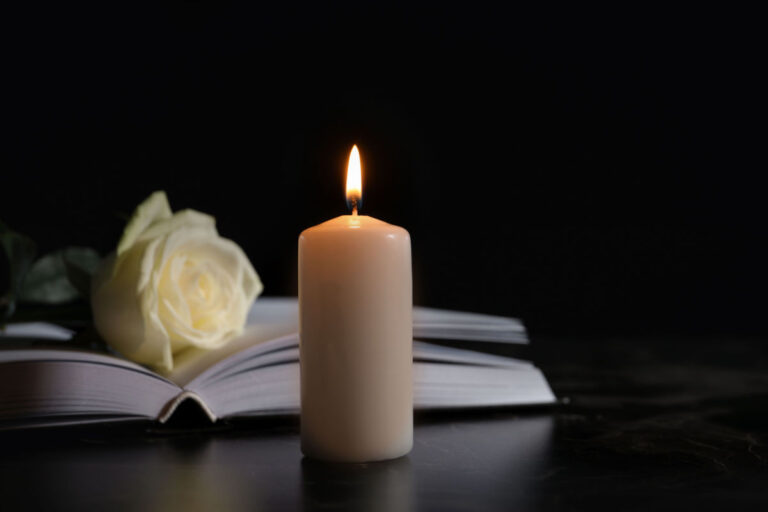Unfortunately, death is a fact of life and sooner or later, you will attend a funeral in Norway. Here’s everything you need to know about what to expect.
A funeral can be an emotionally draining event on the best of days, but attending one in a foreign country adds another layer of stress. Not being familiar with the customs and proceedings, or with what is expected of you, can make an already tough day even more difficult to navigate.

Whether you are planning on attending a funeral in Norway or just want to learn more about how Norwegians pay their final respects to their loved ones, we have got you covered.
Join us as we embark on a journey through time, debunking popular myths (we're looking at you, burning Viking ships) and uncovering the heartfelt traditions that make saying goodbye in Norway a truly unique experience.
The history of funerals in Norway
Much of what we know about funerals in Viking times came to us through the discovery of Viking ships in burial mounds, on many occasions. Chieftains, kings and otherwise wealthy individuals would get buried in a wooden ship, with grave offerings of various kinds.
This kind of grave is obviously very costly. Most people could not afford a ship to sail with, let alone one to be buried in – not to mention expensive grave goods such as bronze trinkets and steel weapons.
But, as is the case with many other cultures, the burials we know the most about are the ones of wealthy people. One thing we are fairly certain of is that Vikings did not set their burial ships asail before setting fire to them.
The myth of Viking cremation at sea
The scene has been depicted so many times in movies and TV series that it has become a trope: A deceased Viking warrior is placed in a ship with grave goods before being set adrift, and a flaming arrow shot from the shore sets fire to the ship. While it makes for a very dramatic scene, Viking funeral ceremonies almost certainly never happened this way.

None of the written records we have about the Vikings mention this ever happening, and not a shred of archaeological evidence has been discovered either. This makes sense when you think of it: Human bodies are mostly made of water, and cremating one requires sustained high temperatures which are difficult to achieve at sea.
What we do know is that Vikings did cremate bodies. Some burial ships bear evidence of this, with large amounts of ashes found near the Myklebust ship, for example.
Gravøl: a burial party to remember
The custom of gravøl (literally: grave beer) dates back to Viking times and persisted in some areas until the early 20th century.
The idea is simple: a big batch of strong beer would be brewed before the death, to be consumed at a burial party of sorts that would last several days.
The funeral itself might have been a sad event, but the gravøl was meant to be a fun one, to put the mind of the deceased at rest that everything would be fine despite their passing.
Since brewing beer takes time, the tradition called for the brewing to take place before the death (sometimes by the very person who’s funeral would be marked in this way).

For sudden deaths of course, things were a bit more complicated. The word gravøl is still sometimes used today to designate the social gathering that takes place after the funeral itself – though it is uncommon today for alcohol to be served at such a gathering.
Modern funerals in Norway
If you attend a funeral in Norway, chances are that it will be in a church. Den Norske Kirken (the Norwegian Church) is part of the Lutheran denomination of Christianity and was established during the Reformation in the 16th century.
There are of course several other denominations in the country, but we are sticking to the Norwegian Church for the purpose of this article because it is the most common. We will also cover non-religious funerals a bit later.
It should be noted that while many funerals take place in churches today, most Norwegians do not regularly attend religious services. In fact, for many, funerals, weddings and baptisms are the only times they are in church.
The funeral programme
Religious funerals in Norway follow a predetermined programme. There may be slight variations in the way this programme is carried out, but the general structure is usually always the same.
The ceremony begins with music, and continues with words of welcome by the priest, and a prayer. Then, a speech about the life of the deceased is given – this can be done either by the priest or by a family member.
After that, more psalms are sung and a passage from the Bible is read. Then, in a slightly unusual ritual, the priest proceeds to go from flower arrangement to flower arrangement, reading the ribbons out loud.
I should mention at this point that the flower arrangements in Norway are placed at various locations of the chancel. They typically feature a large ribbon which bears a short message – often something like En siste hilsen (A last goodbye) – as well as the names of the people offering the flower arrangement.

Because there is usually no wake beforehand, the funeral itself is the first occasion at which the flower arrangements are seen. In that sense, it makes sense for the priest to read them, since one cannot just wander around to take a look during the ceremony, but as an outsider, it felt a bit odd the first time.
After the reading of the ribbons, there is yet another prayer, and either a psalm or a musical performance, based on the wishes (and budget) of the family. It is quite common for the family to hire a professional musician for this part of the ceremony.
Then, the coffin is carried out of the church. If the plan is to cremate the body, the ceremony ends here; for a traditional burial, the priest and bereaved accompany the deceased to their final resting place and complete the ceremony.
After that, the family often (but not always) serves a light lunch and refreshments. Funerals often bring together people that have not met each other in a while, and this is an occasion for them to have a chat and remember the deceased.
What to wear at a Norwegian funeral
A funeral in Norway is a rather formal occasion, so wear nice clothes. For men, this usually means a suit and tie, but nice pants and a shirt are also okay. For women, there are more options but the keyword is discretion.
In other words, avoid short skirts and cocktail dresses. Wearing black is not expected, but stay away from bright colours and loud prints – unless the family of the deceased specify otherwise, of course.
Can anyone attend a Norwegian funeral?
There is no requirement to be a member of the Church of Norway to attend a funeral. Everyone is welcome regardless of their religious beliefs, or lack thereof.
Some families prefer holding a private ceremony. In some of these cases, the death can be announced after the ceremony has taken place.
What time should I show up?
There is no hard rule, but unless you have a specific role to play during the ceremony, the Norwegian Church’s official website recommends showing up around 20 minutes before it starts. This is sufficiently early to ensure there are no delays, and sufficiently late to allow the family to get some time alone before everyone arrives.
Non-religious funerals in Norway
As mentioned earlier, a large portion of the Norwegian population does not attend religious services regularly. Some people prefer planning a non-religious ceremony for their funeral.
These often take place in dedicated facilities owned by the funeral home. The funeral home can help with finding someone to lead the ceremony, and some religious elements can be incorporated (a prayer for example) if desired.
One popular alternative for secular funerals, and indeed for many other rites of passage often marked by a religious ceremony, is to have Human-Etisk Forbund (the Norwegian Humanist Association) lead the ceremony. Humanism is a philosophical and ethical stance that emphasises the value of human beings, both individually and collectively.
The Humanist Association in Norway, receives funding from the government based on the size of its membership, just like religious groups in Norway. As such, they are not a religious group, but they fill the same need in terms of marking important life events, and get their funding in the same way.
Tell us what you think
Have you ever attended a funeral in Norway? What did you think of the experience? What are your thoughts about marking the end of a loved ones life with an entirely secular ceremony? Let us know in the comments!

